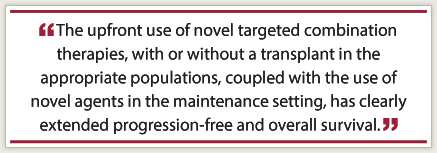 For over 30 years, Kenneth C. Anderson, MD, Kraft Family Professor of Medicine at Harvard Medical School and Director of the Jerome Lipper Multiple Myeloma Center and LeBow Institute for Myeloma Therapeutics at Dana-Farber Cancer Institute in Boston, has focused his translational research on B-cell malignancies, especially multiple myeloma. Multiple myeloma is the second most common blood cancer in the United States, and although the disease remains incurable, the past decade has seen dramatic progress in more effective treatments, increasing median survival from just 3 years to 7 years and beyond.
For over 30 years, Kenneth C. Anderson, MD, Kraft Family Professor of Medicine at Harvard Medical School and Director of the Jerome Lipper Multiple Myeloma Center and LeBow Institute for Myeloma Therapeutics at Dana-Farber Cancer Institute in Boston, has focused his translational research on B-cell malignancies, especially multiple myeloma. Multiple myeloma is the second most common blood cancer in the United States, and although the disease remains incurable, the past decade has seen dramatic progress in more effective treatments, increasing median survival from just 3 years to 7 years and beyond.
At last year’s Annual Meeting, ASCO presented Dr. Anderson with its 2011 David A. Karnofsky Memorial Award in recognition of his outstanding achievements in cancer research and patient care and for his pioneering work in novel, biologically based therapies for multiple myeloma.
The ASCO Post talked with Dr. Anderson about the advancements that have been made in more effective treatments for multiple myeloma and how sequencing the genome in patients with multiple myeloma is revealing the mutational events that lead to development of this cancer.
Role of Novel Agents
For nearly 40 years, from the 1960s until 2000, treatment for multiple myeloma was limited to chemotherapy agents such as melphalan and stem cell transplantation, and median survival was stalled at under 3 years. Today median survival is 7 years. How has so much progress been made in just the past decade?
I think there was an appreciation that novel agents, such as the proteasome inhibitor bortezomib (Velcade) or the immunomodulatory drugs thalidomide (Thalomid) and lenalidomide (Revlimid), could overcome resistance to conventional therapies in preclinical models. And those observations rapidly translated from the bench to clinical trials in relapsed/refractory myeloma, to earlier in the disease course, and most recently as initial treatment. Now, all patients with newly diagnosed myeloma receive these novel agents.
Are these novel agents replacing autologous stem cell transplantation as standard of care in the front-line setting? And what is the role now of stem cell transplantation in myeloma treatment?
The development of proteasome inhibitors, such as bortezomib, and immunomodulatory drugs, particularly lenalidomide, and their independent approval in the treatment of myeloma have altered the transplant paradigm. Preclinical models suggested that combining bortezomib, lenalidomide, and dexamethasone triggered synergistic myeloma killing.
 Clinical trials derived from these findings showed that 58% of patients whose myeloma was refractory to bortezomib or lenalidomide alone responded to the combination of bortezomib, lenalidomide, and dexamethasone. What quickly ensued was the use of that combination as initial therapy in myeloma, which achieved unprecedented results: 100% of patients responded—74% with very good partial responses or better and 52% with complete or near complete responses.
Clinical trials derived from these findings showed that 58% of patients whose myeloma was refractory to bortezomib or lenalidomide alone responded to the combination of bortezomib, lenalidomide, and dexamethasone. What quickly ensued was the use of that combination as initial therapy in myeloma, which achieved unprecedented results: 100% of patients responded—74% with very good partial responses or better and 52% with complete or near complete responses.
As a consequence of those findings, we have launched a large ongoing clinical trial with our colleagues in the United States and France called the IFM-DFCI study, which is enrolling 1,000 newly diagnosed myeloma patients. All study patients receive bortezomib/lenalidomide/dexamethsone combination therapy and then have autologous peripheral blood stem cells harvested. Half the patients go on to get high-dose therapy and a stem cell transplant, and half do not. Both arms of the study will include lenalidomide as maintenance therapy.
This is the first time that a study is asking whether patients who are likely to have significant responses to combination targeted therapies receive additional benefit from stem cell transplant. Already we know that the use of novel therapies such as lenalidomide as consolidation for transplant and for maintenance after transplant has improved progression-free and overall survival in some studies.
Myeloma as Chronic Disease?
The second-generation proteosome inhibitors and immunomodulatory agents are showing promising results in studies for patients with relapsed/refractory disease. Is myeloma being converted from a fatal disease to a chronic illness?
Although we have had remarkable progress in the past decade, I think the best is yet to come. We now have the next generation of proteasome inhibitors, including the intravenous chymotryptic inhibitor carfilzomib and the oral proteasome chymotryptic inhibitors, including MLN-9708 and ONX-0192. There is also the broader inhibitor of the proteasome called marizomib (NPI-0052), which targets chymotryptic, tryptic, and caspase-like activities of the proteasome. Carfilzomib is furthest along in development and has shown remarkable activity even in patients with far advanced relapsed/refractory myeloma, with a very favorable side-effect profile. Based on early studies, the oral proteasome inhibitors MLN-9708 and marizomib are also looking very promising.
In terms of second-generation immunomodulatory drugs, multicenter studies of pomalidomide have shown remarkable activity in relapsed/refractory myeloma, achieving 30% to 40% durable responses in myeloma that is resistant to bortezomib and lenalidomide.
There is also a series of new targeted therapies and combination therapies in clinical trials that hold even greater promise. The upfront use of novel targeted combination therapies, with or without a transplant in the appropriate populations, coupled with the use of novel agents in the maintenance setting, has clearly extended progression-free and overall survival in many patients. Indeed, for many patients, myeloma is now a chronic disease.
Genomic Sequencing
What is the sequencing of the genomes of myeloma patients showing about the diversity of the disease, and how will the findings influence the direction of research?
The first genomic sequencing of human myeloma is a major advance. Unlike other cancers where there is a hallmark genomic abnormality, such as BCR-ABL rearrangement in chronic myelogenous leukemia, there isn’t a predominant mutation found in the majority of patients with myeloma. What genomic researchers found was both very exciting and very consistent with what we know about the biology of multiple myeloma. In particular, there were mutations in pathways of protein homeostasis, consistent with very high levels of protein production and responses to proteasome inhibitors in myeloma.
The investigators found mutations in nuclear factor–kappaB, which is an important transcriptional regulator in multiple myeloma implicated in tumor cell growth, interaction with the bone marrow, and production of cytokines. Mutations in interferon regulatory factor 4 and Blimp-1, which are required for normal B-cell differentiation to plasma cells, are again consistent with B- and plasma-cell biology. They also found mutations in histone methyltransferases, which is again consistent with prior observations, including MMSET in the t4;14 translocation subset of multiple myeloma.
A surprising finding in patients’ tumor cells was the BRAF V600E mutations that have been found in malignant melanoma. In the case of the V600E mutation there may be really short-term implications because there are already drugs, such as vemurafenib (Zelboraf), that are being used in melanoma that could now be examined and tested for efficacy in the 4% of patients who have that lesion in myeloma.
So this genomic study has shown that mutations are found in patients with multiple myeloma and that the disease is genetically heterogeneous.
Genetic Profiling
Will genomic tumor typing be available to all myeloma patients in the near future?
Genomic profiling is moving very rapidly from research to the clinical realm. The cost is coming down very quickly and the ability to carry out the assays at a clinical level is also rapidly progressing. I do think that there will be genetic profiling of patients, which will consist of an integrated characterization of their DNA with copy number analysis, RNA with microarray profiling, and microRNA profiling with mutation analyses.
It will be a multilayered integrated profile of patients’ tumor cells not only at the time of diagnosis but also at the time of disease relapse, because we and others have shown that the genetic profile—in terms of DNA, RNA, microRNA, and mutations—does change as the patient’s disease progresses.
We have had great progress in myeloma in the past 5 years, the result of cutting-edge genomics and bench-to-bedside drug development collaboration between academic centers, biotech and pharmaceutical companies, regulatory agencies, and funding and research support agencies, such as the NCI, as well as patients and patient foundations. The best is yet to come. ■
Disclosure: Dr. Anderson is on the advisory board for Millennium Takeda.

